Svalbard Travel Guide
Date Visited: June 2022
Introduction
Svalbard is as close as most mere mortals can get to the North Pole, without embarking on an expedition.

A polar bear warning sign outside of Longyearbyen. “Gjelder hele Svalbard” means that the warning applies to all of Svalbard.
A truly magical and surreal archipelago, whose landscapes include pointy, snow-covered peaks and huge glaciers which calve into the sea, Svalbard is home to more polar bears (~20,000) than people.

Dramatic scenery is a constant in this part of the world.
Outside of the settlements, you (or a guide) are required to carry a loaded rifle as protection against polar bear attack.

A view of the mighty Esmark glacier.
One of the world’s northernmost inhabited areas, the main settlement of Longyearbyen lies at latitude 78˚ North – just 1,316 km (817 mi) south of the North Pole.

A beach cabin provides a sense of scale to the monumental scenery on Svalbard.
Svalbard is one of Europe’s last great wildernesses, and the many highlights of the archipelago are to be found along the shores of the remote and uninhabited fjords – the world’s northernmost fjords!

A trip to the abandoned Soviet mining town of Pyramiden is a highlight of Svalbard.
Svalbard’s main settlement, and entry point, is tiny Longyearbyen (pop: 2,368), which is home to a young, transient population of 53 different nationalities.

A view of the Norwegian town of Longyearbyen, the largest settlement on Svalbard.
Svalbard has a unique immigration policy which allows anyone with a work contract to settle and live on the island, regardless of nationality, without requiring any sort of visa!
This attracts a large number of seasonal Asian workers, especially hard-working Filipinos, many of whom have learnt to speak some Norwegian. See the ‘Visa Requirements‘ section below for more on this.

Typical scenery on the Isfjorden, Svalbard.
Travel costs on Svalbard are very high, with a daily budget likely to be in the region of €400 – 500 if you are staying in a decent hotel and participating in a boat trip on the fjord.

The world’s northernmost Fjord, the Billefjorden, is lined by an uninterrupted range of towering mountain peaks.
Svalbard would be a challenging destination for budget travellers! The main target tourist market is established, well-monied travellers who are prepared to pay €200 for a daytrip on a boat (please refer to the ‘Cost‘ section for more details).

Getting up close to a walrus colony is one of many amazing activities on Svalbard.
One of the highlights of my trip was a 7-hour Walrus safari which was operated by the excellent team from Better Moments. The trip involved 6 hours on a speedboat and one hour on the beach with the walrus colony.
The cost of this trip was an eye-watering NOK2,390 (€231) – but it did include a ham sandwich for lunch!
Despite the cost, it was well worth the money and I would recommend it to anyone visiting Svalbard. It would be a shame to come this far and baulk at doing something unique like the walrus safari because of financial considerations.

The abandoned staff cafeteria in the former Russian coal mining town of Pyramiden, a remote ghost town which is now an intriguing tourist attraction.
Svalbard is also home to two Russian coal mining towns, Barentsburg and the, now-abandoned, Pyramiden, both of which are popular daytrips from Longyearbyen.

Mountain peaks surround the settlement of Longyearbyen.
In this Svalbard Travel Guide, I provide a detailed overview of sights, accommodation and restaurant options along with information on getting to the archipelago and getting around.

Community noticeboard, frozen in time, in the former Soviet mining town of Pyramiden.
Location
Longyearbyen 9170, Svalbard and Jan Mayen
Svalbard, also known as Spitsbergen, is a Norwegian archipelago located between mainland Norway and the North Pole. Longyearbyen lies 2,000 km north of Oslo and 836 km north of Nordkapp (the northern most point in Norway).
Due to its extreme northerly position, Svalbard experiences 2.5 months of complete darkness – the “Polar Night” – from mid-November to late January.
During the summer, the “Midnight Sun” is omnipresent (somewhere above the cloud), lasting from late April to late August.
History

Due to its many pointy peaks, Svalbard was originally named ‘Spitsbergen’ by the Dutch explorer Willem Barentsz.
Svalbard, which translates from Old Norse as “Cold Coast”, was originally discovered by Dutch explorers Willem Barents and Jacob van Heemskerck in June 1596.
They named the archipelago Spitsbergen, meaning “pointed mountains”, due to the many pointed mountain peaks which line the coast.

One of two inhabited settlements on Svalbard, the Russian mining town of Barentsburg is named after the Dutch explorer, Willem Barents.
At the time of their arrival, they reported that so great was the number of whales, that navigating between them was difficult.
With the word out, Dutch and English whalers arrived as early as 1611, followed by French, Hanseatic, Danish, and Norwegian whalers, all of whom started arguing over whaling rights and the division of territory.
Eventually, by the time the arguments had settled, they had slaughtered almost all of the whales!

Remains of a coal mine cable-way in Longyearbyen.
With the decline of whaling by 1800, the islands’ importance centred on the presence of coal. The coal deposits on Svalbard date back millions of years, to a time when the archipelago was located in the tropics and was covered with lush vegetation. The deposits are close to the surface which is attractive for mining companies.
Not until the beginning of the 20th century were the deposits surveyed and mineral rights claimed by American, British, Norwegian, Swedish, Dutch, and Russian companies and individuals.

A simple memorial to John Munroe Longyear among the ruins of the old town of Longyearbyen.
One American to arrive on the island was businessman and mining pioneer John Munroe Longyear, who first visited Svalbard on a cruise in 1901, and became interested in developing a coal mining operation.
In 1906, he established the Arctic Coal Company which developed several mines and the associated infrastructure. He named his settlement Longyear City.
In 1916, the Norwegian company, Store Norske Spitsbergen Kullkompani, took over the mining operations from Longyear’s Arctic Coal Company, and the settlement was renamed Longyearbyen (“Longyear City” in Norwegian).
Svalbard Treaty
The Svalbard Treaty was signed on 9 February 1920 and entered into force on 14 August 1925. The treaty granted possession of the archipelago to Norway and mineral rights, on an equal basis, to various European and other countries.
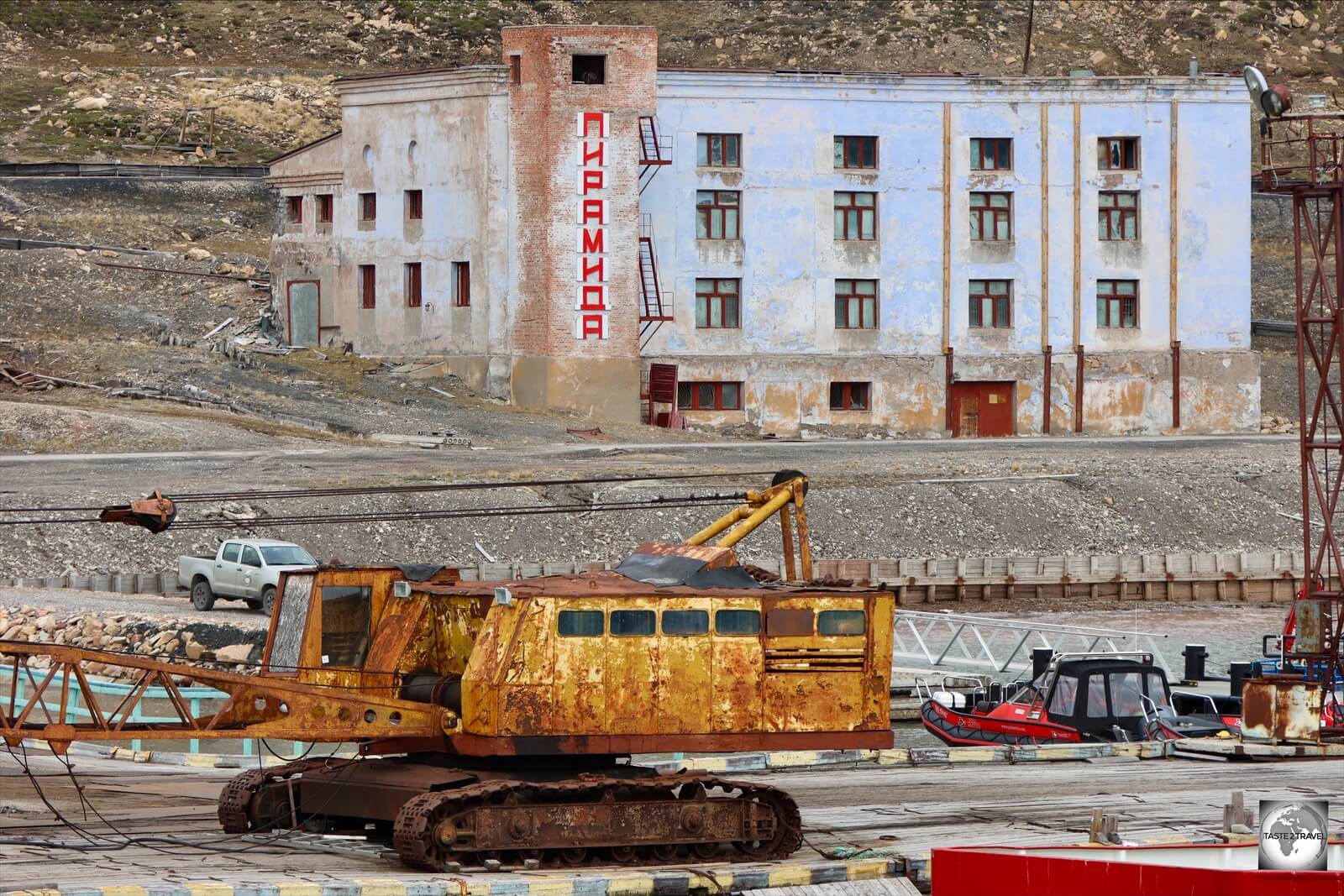
The abandoned Russian coal mining town of Pyramiden is today a popular tourist attraction.
Only Russia and Norway continue to extract and export coal from mines on the islands, with one mine each operating in Longyearbyen and Barentsburg.
The main economic activity on Svalbard today is tourism.
People
Svalbard has never been home to a native population, unlike neighbouring Greenland which was originally settled by the native Inuit.
Anyone living on Svalbard has arrived from somewhere else.
With a population of 2,368 – Longyearbyen is a cosmopolitan Arctic village whose residents come from no less than 53 different countries.
Unlike everywhere else in Europe, there is no social security on Svalbard which ensures that anyone who is resident is fully self-sufficient and employed.
Limited medical facilities ensure that anyone requiring medical attention, such as the elderly, cannot live on the archipelago.
Due to these conditions, the population of Longyearbyen is generally young, fit, healthy and fully employed. The average age is a relatively young, 30 years, with the bulk of the population being transient, remaining for a few years on short-term work assignments.
Many of the work contracts cover the short summer tourism season, with workers staying on the archipelago for less than 6 months.

Foundation supports, from one of the original buildings in Longyearbyen, have been tilted by the movement of the underlying permafrost.
There are also two important restrictions which apply to the human population on Svalbard:
- No one can be born on Svalbard.
- No one can be buried on Svalbard.
Due to the limited medical facilities in Longyearbyen, anyone who is pregnant must relocate to Norway, normally Tromsø, for the final term of their pregnancy.

The underlying permafrost is visible in this gully outside of Longyearbyen,
No one can be buried on Svalbard for two good reasons:
- Due to the seasonal movement of the earth caused by the thawing and then re-freezing of the underlying permafrost, no one can be buried on Svalbard, lest their body starts re-emerging from the frozen ground at some stage in the future.
- Bodies simply won’t decompose in the frozen ground.

A view of the Russian mining town of Barentsburg, the 2nd largest settlement on Svalbard.
The one other settlement on Svalbard is the Russian mining town of Barentsburg, which is located 40 km (about 1 hour by boat) to the south-west of Longyearbyen. This very quiet town is home to a population of 455 souls from Russia and Ukraine.
Facilities in Barentsburg are limited with residents using Longyearbyen for most services, including the airport.
Currency

Norwegian Krone currency.
Image source: Manorfx.com
The currency of Svalbard is the Norwegian krone (currency code: NOK), whose name translates into English as “crown”. The currency is issued in notes of 50, 100, 200, 500 and 1000 krone.
The krone (plural: kroner) is used throughout Svalbard, including in the Russian settlement of Barentsburg.
Credit Cards
If you came to Svalbard without cash, that would not be a problem since every business accepts payment with credit cards. If you prefer to use cash, there is an ATM available in Longyearbyen.
Exchange Rates
Click on the links to view the current exchange rate of 100 NOK against the Euro and US dollar:
Philately
Lonyearbyen Post Office

The famous polar bear roadside warning sign is featured on a Svalbard stamp.
Postal services on Svalbard, including in the Russian town of Barentsburg, are provided by Norwegian Post, which issues a separate set of Svalbard stamps. The one post office in Longyearbyen is located on the main street.

Located at 78° North, Longyearbyen PO is the world’s northernmost post office.
Svalbard Postmarks
The post office in Longyearbyen also uses unique postmark stamps, featuring a polar bear and reindeer.

The polar bear and reindeer postmarks, which are used at Longyearbyen PO.
When I first saw these postmarks, I commented to the post office staff that these would make ideal souvenir passport stamps, since no immigration stamp exists for Svalbard.
I was told that the post office has been instructed by the government not to stamp passports with these postmarks.
Barentsburg Post Office

The post office in Barentsburg, which is operated by Norwegian Post, is a great place for souvenir shopping.
Located on the main street in Barentsburg, the local post office in this Russian town is operated by Norwegian Post since Svalbard is a territory of Norway.
The post office sells a variety of souvenirs.
Costs

Spectacular day trips on the world’s northernmost fjord are the main activity for most tourists on Svalbard.
Horrendous!
Svalbard is not a destination for anyone on a budget.
For most people, Svalbard will be a one-time travel experience. It’s best to come with enough funds to enjoy the many amazing experiences which await in this unique Arctic playground and not to be too focused on just how much everything is costing you!
Due to the high travel costs, it’s best to bite the budget bullet, do what you wish to do, then leave before your travel budget disappears entirely.
Svalbard would be a miserable travel experience for anyone pinching their pennies!
An example of typical daily costs:
- Hotel room at Radisson BLU Polar hotel (includes breakfast): €230
- Full day trip to Pyramiden with Henningsen Transport & Guiding (includes lunch): €184
- Dinner at Stationen Restaurant (Steak meal with one local beer): €42
- Total for one day = €456
Suggested daily budgets:
- Budget: Not possible!
- Mid-range: NOK 4,000 – 4,648 (€380 – 450)
- Top-end: NOK4,648+ (€450+)

The ‘Circle K’ petrol station in Longyearbyen is the world’s northernmost petrol station, where a litre of fuel costs NOK14.70 (€1.42).
Sample costs:
- Coca Cola (0.33 litre bottle): NOK35 (€3.38)
- Water (0.5 litre bottle): NOK24 (€2.33)
- Svalbardi Polar Iceberg Water (750ml bottle): NOK982 (€94.95) ** Possibly the most expensive bottle of water in the world! **
- Cappuccino at Café Huskies: NOK44 (€4.26)
- Svalbard Brewery craft beer at Stationen Restaurant (.3L / .5L): NOK72/ 96 (€7.00/ €9.28)
- Eggs Benedict breakfast at Stationen Restaurant: NOK165 (€15.96)
- Steak meal at Stationen Restaurant: NOK335 (€32.40)
- Budget Accommodation – ‘Standard Twin’ room at the Coal Miners’ Cabins (per night): NOK1,645 (€159)
- Budget (Dormitory) Accommodation at Gjestehuset 102: NOK500 (€48)
- Mid-Range Accommodation – ‘Standard Double’ room at the Radisson Blu Polar Hotel Spitsbergen (per night): NOK2,395 (€230)
- Taxi from airport to town centre: NOK180 (€17.42)
- Fuel (1 litre): NOK14.70 (€1.42)
- Daytrip to Barentsburg (10 hours) with Polar Charter: NOK1,950 (€188)
- Daytrip to Pyramiden (11 hours) with Henningsen Transport & Guiding: NOK1,900 (€184)
- Walrus Safari (7 hours) with Better Moments: NOK2,390 (€231)
- Roundtrip airfare from Oslo to Longyearbyen with either Scandinavian Airlines or Norwegian Air Shuttle: ∼ NOK7,000 (€678)
Shopping
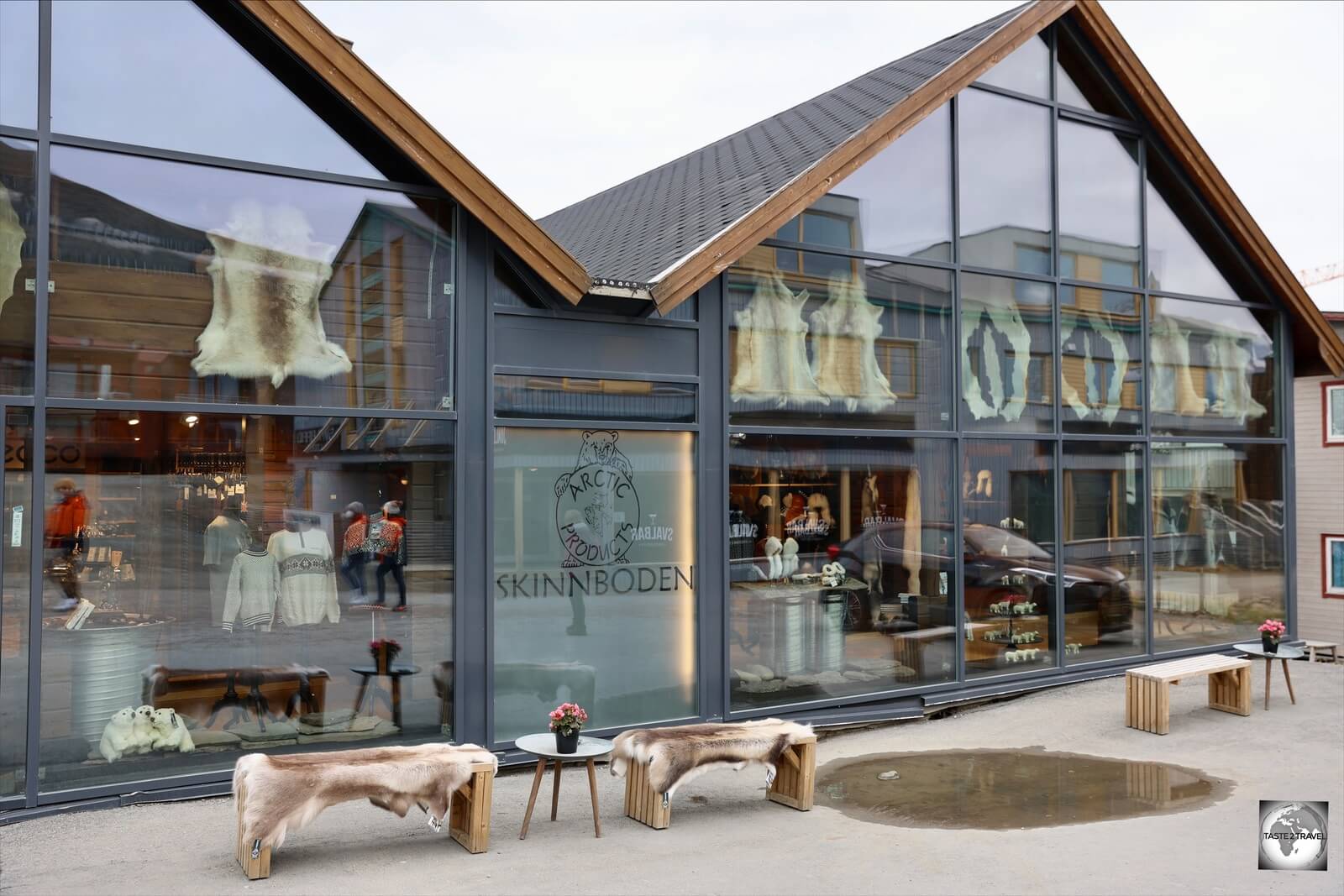
The main street of Longyearbyen is home to a selection of boutiques which sell a range of Arctic merchandise.
While other costs are high on Svalbard, shopping can be a bargain! Svalbard is a duty-free zone so lower tax-free prices apply for everything you buy.

Funky local artwork for sale in Longyearbyen.
You will find bargain prices on outdoor clothing and equipment at Longyearbyen’s sporting goods stores, while the price of alcohol and tobacco are considerably lower than on the Norwegian mainland.

Located on the main pedestrian mall in Longyearbyen, the Coop supermarket is a great place to find bargain souvenirs.
If you are interested in purchasing souvenirs, the local supermarket, Coop, has a great range of items at very reasonable rates. This is also the only supermarket in town!

Items for sale in the gift shop at Pyramiden.
Shopping opportunities exist in Longyearbyen and in the Russian towns of Barentsburg and Pyramiden, where you’ll find at least one or two shops selling souvenirs.
Svalbard Wildlife
Introducing a gallery of Svalbard wildlife!
Unfortunately, the elusive polar bear proved to be too elusive during my stay on Svalbard, and so sadly, was never photographed by me!
Click on images for the full gallery-view.
Arctic Cruises

Cruise ships in Longyearbyen harbour.
Most visitors to Svalbard are cruise ship passengers who overnight in Longyearbyen before and after an Arctic cruise. The cruising season runs from late-April through late-September.
During the 2019 summer season, ~300 cruise ships visited Svalbard, carrying around 20,000 tourists.
Being the only settlement with services in this part of the world, Longyearbyen is a hub for all cruise ship companies. Most passengers arrive in town on special charter flights, which saves the (limited) regularly scheduled flights from being inundated!
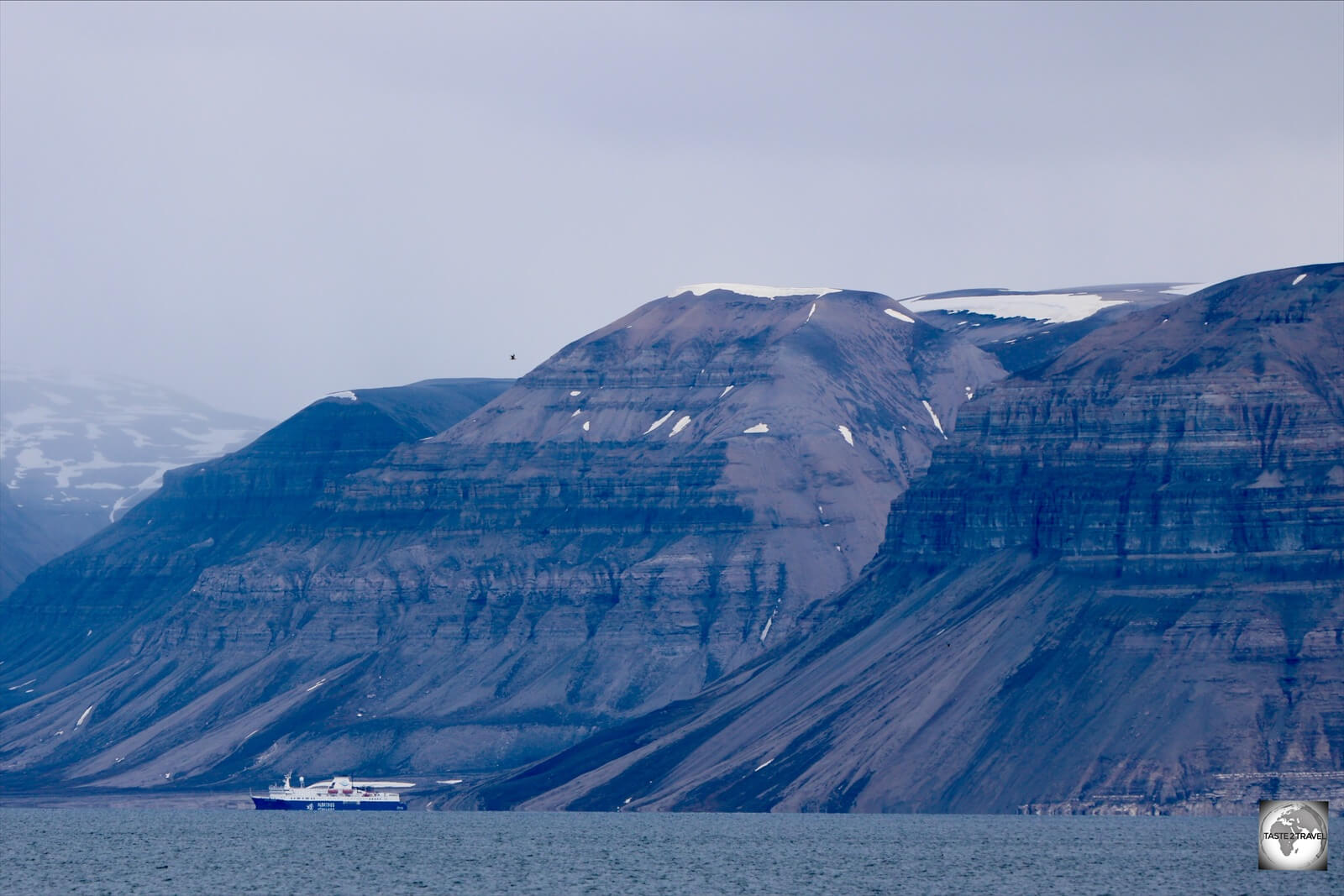
A cruise ship is dwarfed by the towering mountains of Svalbard.
The summer cruise season of 2022 was the first time that Svalbard had been open since the summer of 2019, due to the Covid-19 pandemic.
Rather than cancelling cruises in 2020 and 2021, and refunding money back to passengers – which would have resulted in companies becoming bankrupt – the cruise ship companies rescheduled everyone for the 2022 season.
This meant that three years’ worth of passengers were being pushed through the system in one year! This resulted in a huge amount of congestion in tiny Longyearbyen, where, on one day, 8 cruise ships were in port, which overwhelmed the town of 2,400 inhabitants.

With a passenger capacity of 2,500, TUI Cruises’ “MV Mein Schiff” doubled the population of Longyearbyen during its one-day stopover.
On another day, TUI cruises arrived in town, with their mega-ship, ‘MV Mein Schiff 4’ whose passenger capacity matched the population of Longyearbyen, resulting in a doubling of the town’s population.
Having been closed for 3 years, local tour operators, and businesses, were happy to have the cruise ship passengers back in town – even if town was crowded!
A typical 10-day Arctic cruise costs around US$10,000. You can view a selection of cruises on the Swoop Arctic website.
Sightseeing
Tip: For a full list of activities on Svalbard, you should refer to the Things To Do page on the Visit Svalbard website.
You can also make bookings directly from this page.
Longyearbyen
The main town on Svalbard, Longyearbyen (population: 2,368) has the distinction of being the world’s northernmost town, located at 78˚ North – 1,316 km (817 mi) south of the North Pole, and well above the Arctic circle, which is located at 66°30′ North.
While there are two museums and a few other sights in town, Longyearbyen mainly serves as a base for full-day boat trips, exploring the many spectacular sights which are located along the shores of the fjords.
Svalbard Museum

The engaging Svalbard Museum displays artefacts from the history of Svalbard since its settlement along with fauna and flora displays.
A good first stop for any new arrival in town, the Svalbard Museum includes displays on the local fauna and flora of the archipelago, including an impressive (stuffed) polar bear.
Apart from being a natural history museum, Svalbard Museum is a cultural museum and includes displays which tell the story of settlement on the archipelago.
At the time of my visit, there was a special exhibition on permafrost – which affects much in this part of the world.
North Pole Expedition Museum

The North Pole Expedition Museum tells the story of early attempts to reach the North Pole.
Located directly behind the Svalbard Museum, the North Pole Expedition Museum tells the story of man’s early attempts to reach the North Pole, especially using airships and other types of aerial craft.

Displays inside the North Pole Expedition Museum, one of two museums in Longyearbyen.
The museum displays, which cover two floors, includes relics from expedition ships and air ships, old newspapers, maps and more.
Svalbard Church

Svalbard church was receiving a new roof at the time of my visit.
Located in an area of town which was the sight of the original settlement, the very cute Svalbard Kirke (church) is a warm and inviting place whose door is always open.
On the subject of open doors – it is standard practice on Svalbard that all doors to buildings remain unlocked, in case it is necessary for someone to hide from a wandering polar bear.

The altar inside Svalbard church.
The red, wooden church was built in 1958 using plans drawn up by the architect Hans Magnus. The church seats about 140 people and includes a stuffed polar bear (of course!)
Like everything else on Svalbard, the church has the distinction of being the northernmost church in the world and is one of two churches on Svalbard, with the other being a Russian Orthodox chapel in Barentsburg.
Svalbard Global Seed Vault

The Svalbard Global Seed Vault is also known as the Doomsday Vault.
Located outside of Longyearbyen, high on a mountain, overlooking the airport, the Svalbard Global Seed Vault is essentially a huge safety-deposit box for seeds.
Like something from a James Bond film, the entrance of this remote facility is a rectangular wedge of concrete which juts out from the side of a mountain.
The door to the vault is always closed and visitors are not allowed, lest someone introduces any sort of bacteria which would contaminate the valuable seed collection.
Beyond the entrance, a 150-metre-long passage leads to 3 chambers, with just one chamber currently used to house seeds.

Alone in isolation at the top of the world – the Svalbard Global Seed Vault is essentially a huge safety-deposit box for seeds.
The Global Seed Vault, which has been dubbed the “doomsday” vault, stores seeds from around the world – seeds which account for more than 930,000 varieties of food crops.
In 2008, Time Magazine named the Global Seed Vault as one of the ‘best inventions of 2008‘.
Husky Kennels

Common Eider ducks nesting alongside the noisy Husky kennels.
Located a short walk outside of town, the very noisy husky dog kennels are used to house these working dogs which are vitally important for sledding activities during the long, cold winters.

A female Common Eider duck, sitting on her comfortable nest which is made from Eider-down feathers!
All of the noisy racket from the constant barking and howling of the dogs, makes this a fox-free zone, which in turn makes this an ideal nesting site for the Common Eider duck.
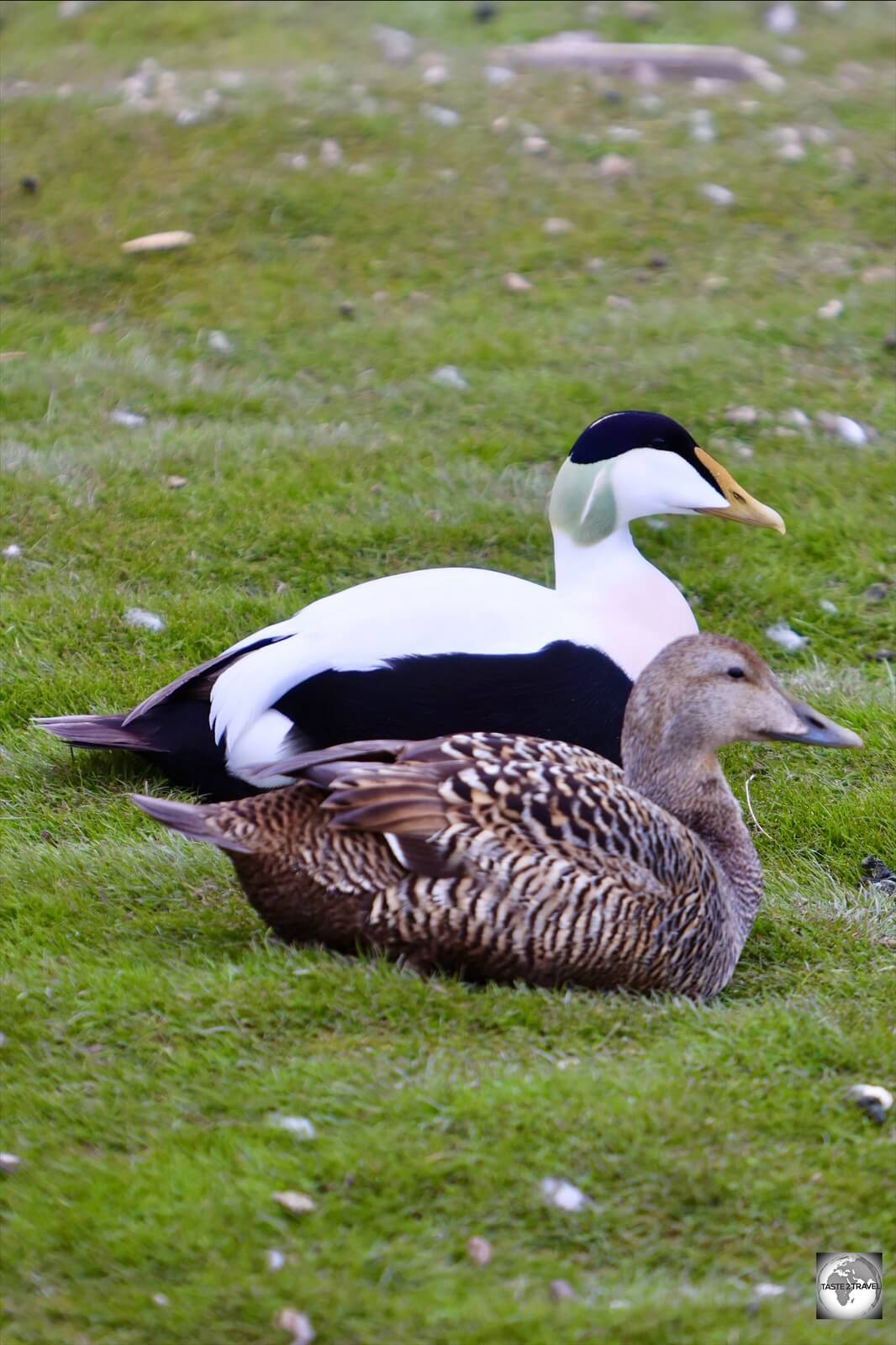
A female (foreground) and male pair of Common Eider ducks in Longyearbyen.
The Arctic fox is one of the main predators of the ducks, which are most vulnerable while they are nesting. A large duck, the common eider duck is usually easily recognized by its size, the black belly and the white back of the male.
Previously, the excellent insulating down was collected from the nests of eider ducks for clothing or blankets.
Walrus Safari Daytrip

One of the best-known walrus colonies close to Longyearbyen is on Poolepynten on Prince Karl’s Fordland.
One of the highlights of my trip to Svalbard was being able to get up close to a colony of sunbathing walruses.

The walrus colony at Poolepynten on Prince Karl’s Fordland is located 87 km northwest of Longyearbyen, a 3-hour ride by speedboat.
During the winter months, walruses spend their time on sea ice. During summer, when the sea ice melts, walruses congregate on beaches such as at Poolepynten on Prince Karl’s Fordland, which is 87 km northwest of Longyearbyen.

Found only in the Arctic, there are two species of walrus – the Pacific and Atlantic walrus, with the Atlantic walrus found on Svalbard.
Both males and females grow tusks which they use to haul themselves out of the water and onto the sea ice. Their tusks are also used for keeping breathing holes open in the ice, fighting with other walruses, and for defence against predators.

Walruses use their sensitive whiskers for feeling out mussels and other sea creatures in the dark, Arctic waters.
Due to its great size and tusks, the walrus has only two natural predators: the orca and the polar bear.

Despite having no trees, the beaches of Svalbard, such as Poolepynten, are littered with ancient logs which have been carried to the Archipelago on ocean currents.
The walrus does not, however, comprise a significant component of either of these predators’ diets. Polar bears are more partial to seals!

Our Walrus Safari guide, with his loaded rifle, always on the lookout for polar bears.
I travelled on a Walrus Safari with Better Moments who charge NOK2,390 (€231) for the 7-hour trip. This included a lunch, which was a ham sandwich!

A ‘wet landing’ by dinghy at the very remote Poolepynten beach, with our speed boat in the background.
The safari involved a 6-hour return speedboat trip and one hour on the beach. As there is a risk of polar bear attack, our guide was required to carry a loaded rifle.

The scenery on Prince Karl’s Fordland.
Barentsburg & Esmark Glacier Daytrip
Travel Tip
For anything related to tourism in the Russian towns of Barentsburg and Pyramiden, you should consult with Grumant Arctic Travel Company.
Disclosure: At a time when Russia is waging an illegal invasion of Ukraine, it is incumbent upon me to disclose that the Grumant Arctic Travel company is a division of the Arktikugol (Arctic Coal) mining company, which is owned by the Russian government.
Trips to Barentsburg and Pyramiden from Longyearbyen use Norwegian companies.
A daytrip to Barentsburg always includes a stop at the impressive Esmark glacier which lies on the opposite side of the fjord from the Russian mining town.

Daytrips to Barentsburg include a stop at the Esmark glacier.
I travelled on a daytrip with Polar Charter aboard the MV Polar Girl who charge NOK1,950 (€188) for the 10-hour trip. This included a bowl of soup for lunch and a guided tour of Barentsburg.

The ‘MV Polar Girl’ offers day-trips to Barentsburg and Pyramiden.
Esmark Glacier

Two zodiac boats are dwarfed by the front of the Esmark glacier, which is 15 km wide.
The first of two stops on the daytrip was at the impressive Esmark glacier which calves into Ymerbukta bay, on the northern side of Isfjorden.

Two zodiac boats provide a sense of scale for the huge Esmark glacier, one of hundreds of glaciers on the archipelago.
The last remains of winter fast ice in front of the glacier were slowly melting.

Our boat, breaking through the last of the winter “fast ice”, the preferred habitats for seals, on approach to the huge Esmark glacier.
As we approached the glacier, our boat broke through the last of the fragile winter “fast ice”.
Fast ice is the preferred habitat for seals who escape the threat of polar bears by resting on the ice rather than on land.

Polar bear tracks, on the fast ice, in front of the Esmark glacier.
As a magnet for seals, the fast ice is also the preferred hunting ground for polar bears, whose favourite meal is seal. While we saw polar bear tracks on the ice, the tracks were not fresh and we saw no sign of polar bears.

View from the MS Polar Girl as we cross the Isfjorden en-route to Barentsburg.
Barentsburg

A bust of Lenin looks out over Barentsburg.
Located 60 km west of Longyearbyen, in Grønfjorden (Green Fjord), a small fjord to the west of the larger Isfjorden, the quirky Russian mining town of Barentsburg is home to a population of 455 souls who are both Russians and Ukrainians.

Traditional wooden buildings in Barentsburg.
Barentsburg was first established by a Dutch company in 1920, who named the settlement in honour of the famous Dutch explorer Willem Barentsz.

The one school building in Barentsburg features artwork which adds a splash of colour to this Arctic mining town.
In 1932, Barentsburg was sold to the Soviet state-owned company Arktikugol, and ever since the fall of the Soviet Union the community has been maintained by the Russian state-owned company Trust Arktikugol.
Apart from running the mining operation, the company owns the Grumant Arctic Travel Company. If you wish to stay overnight in Barentsburg, the travel company operates one hotel and one hostel (see the ‘Accommodation‘ section below for more details).
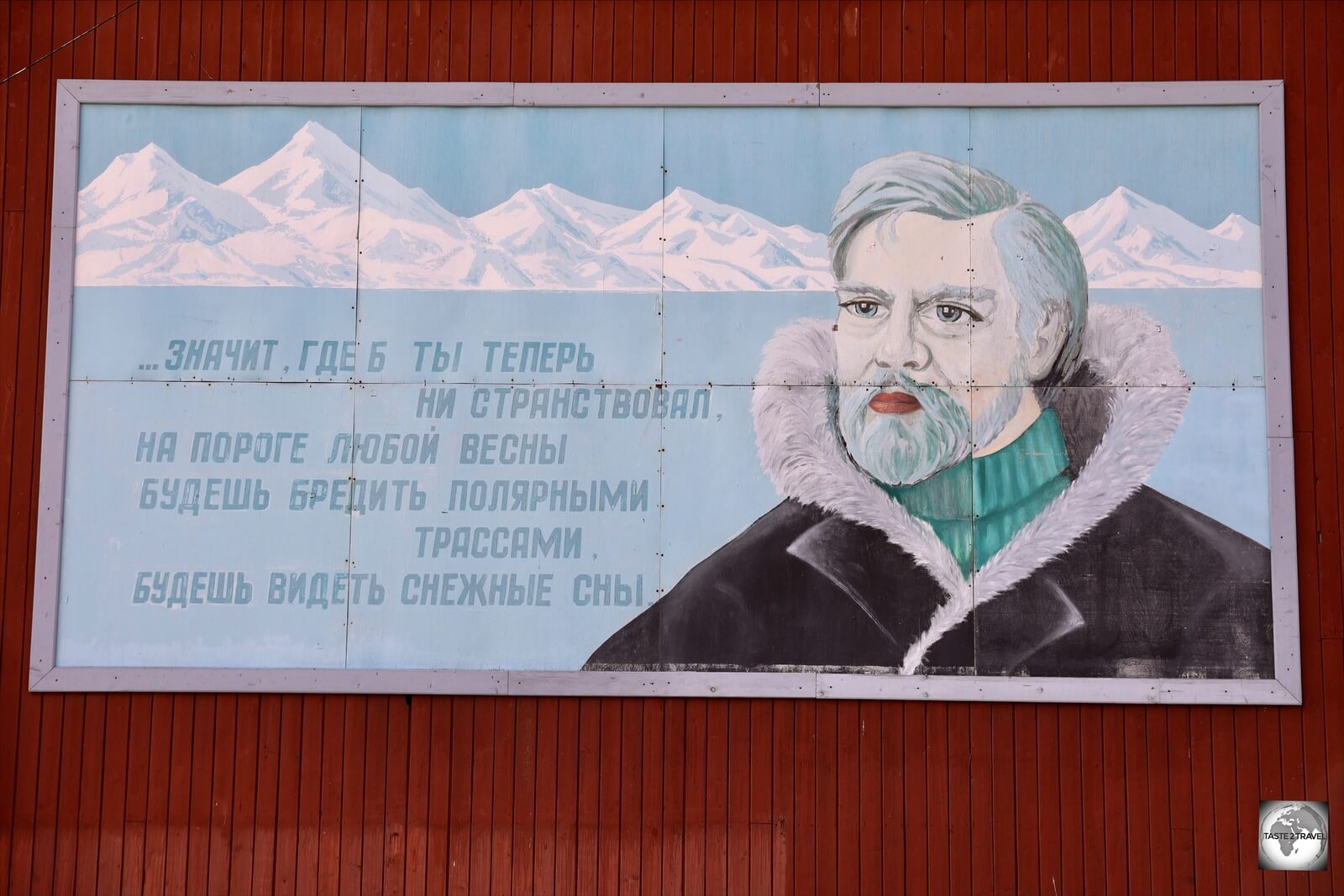
Artwork adorns the side of the abandoned workers’ cafeteria building in Barentsburg.
The currency in use in Barentsburg is the Norwegian krone (NOK) with credit cards accepted by most businesses.

The port authority building in Barentsburg.
During WWII, the Germans destroyed almost all buildings in Barentsburg which makes the current town relatively new.

Sleepy Barentsburg is a living museum of a Soviet-era mining town, complete with many fine Pomor-style wooden buildings.
Barentsburg is a living museum, full of relics from its Soviet past, including many fine Pomor-style wooden houses.
During our visit we had a one-hour guided tour around town, then time to ourselves to explore.

The logo of the Arktikugol company which operates the town of Barentsburg.
The town has its own coal-powered power plant, hospital, hotel, hostel, brewery, two bars, school, kindergarten, cultural and sports-facilities, one supermarket and one Lenin bust.

The former Soviet consulate was built in the classic Stalinist style while the new Russian consulate looms in the background.
Although this is a Russian mining town, Svalbard is a territory of Norway and, as such, the Russian government is represented in Barentsburg through a consulate.
The former consulate, which was built during the Soviet era in the classic Stalinist style, is now a museum while a modern Russian consulate, built directly behind the former consulate, overlooks the whole of the settlement from its hilltop position.

One of four apartment buildings in Barentsburg.
Compared to Longyearbyen, Barentsburg is very quiet and sleepy. There are few cars, few businesses, few shops and a general lack of buzz and activity. It’s all very quiet!

A Soviet-era sign outside a modern apartment building in Barentsburg proclaims “Communism is our goal”.
I saw very few people walking around the few streets which comprise the downtown area. It’s in complete contrast to the more bustling Longyearbyen!

The Russian orthodox chapel in Barentsburg is the world’s northernmost Orthodox chapel.
One sight worth visiting is the wooden Russian Orthodox chapel, the world’s northernmost Orthodox chapel.
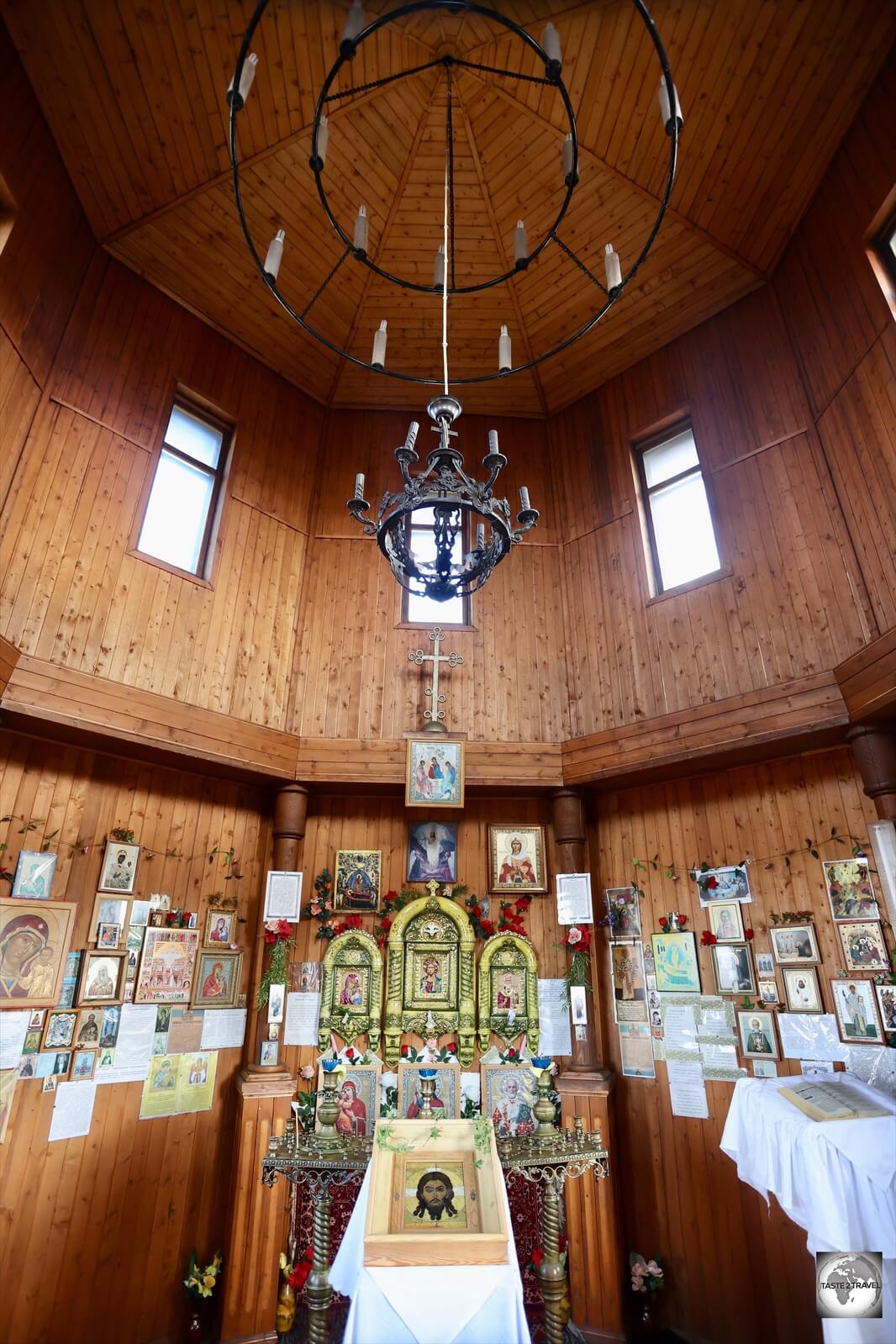
The interior of the Russian Orthodox chapel in Barentsburg.
It was erected in honour the victims of an air disaster which occurred in 1996 when a Tupolev plane carrying 141 miners from the Arktikugol company, crashed into a mountain on approach to Longyearbyen airport. It was this event which led to the closure of Pyramiden.
Grumant
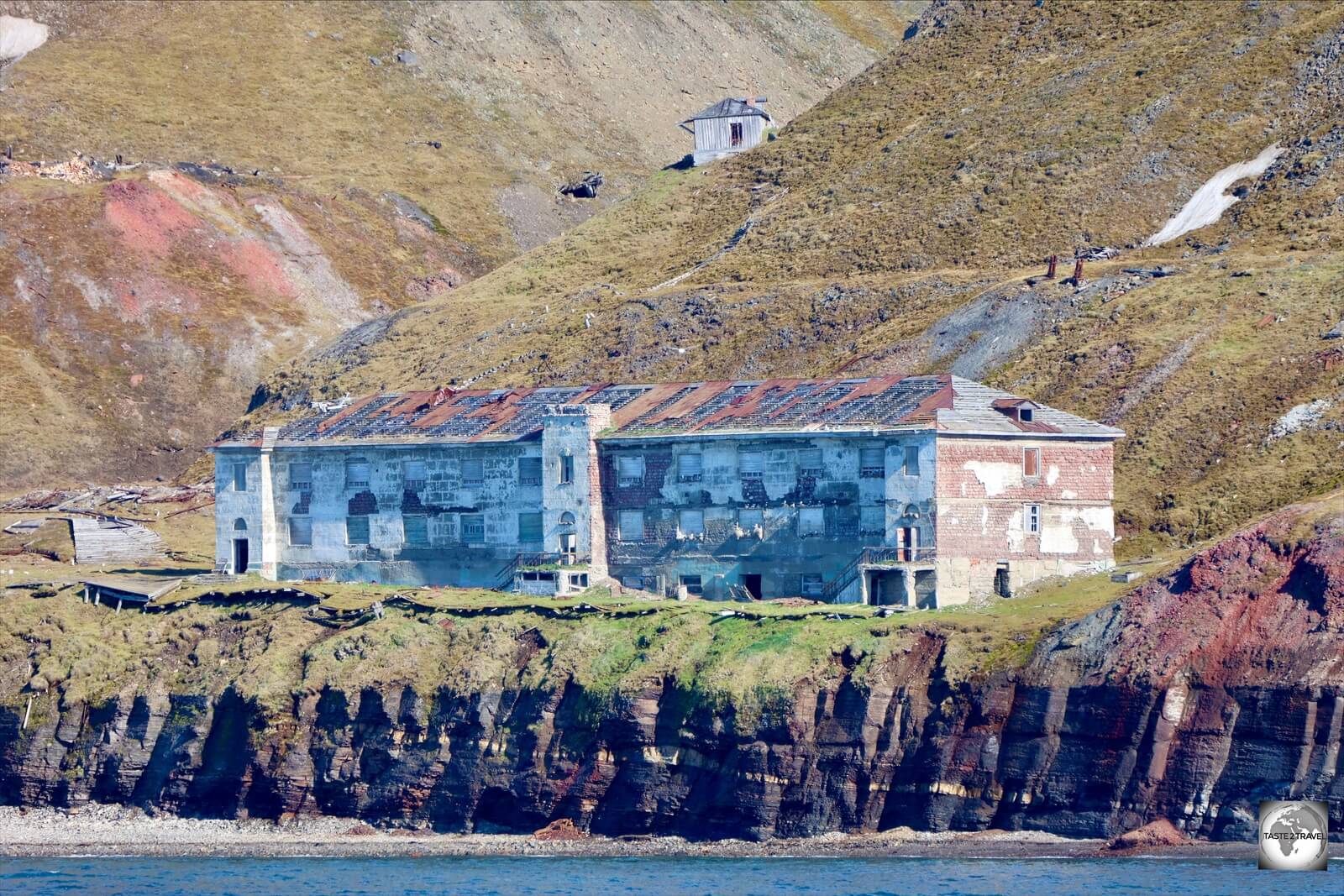
Abandoned buildings in the Russian settlement of Grumant.
Located on the southern shore Isfjorden, the Russian mining town of Grumant was first established in 1912 and then abandoned in 1965.
At its peak, it was home to 1,106 coal miners. Due to a lack of port facilities, coal had to be transported to nearby Coles Bay via a rail line. It all proved too difficult and costly and the settlement was eventually abandoned in 1965.

Abandoned buildings at the former Russian mining settlement of Grumant.
Pyramiden & Nordenskiöld Glacier Daytrip

The abandoned Russian mining town of Pyramiden lies 50 km north of Longyearbyen.
A highlight of Svalbard, Pyramiden is an abandoned Soviet coal mining settlement, which is located at the foot of the Billefjorden, near to the massive Nordenskiöld Glacier.

Minerals colour the soil of a mountain slope on the Billefjorden.
Several companies run daily trips from Longyearbyen which include scenic views of the Billefjorden, a trip to the Nordenskiöld Glacier and a guided tour of Pyramiden.
I chose to travel with Henningsen Transport & Guiding (HTG) who offer the 11-hour trip for NOK1,900 (€184), which includes a BBQ lunch, prepared by the excellent and friendly Filipino crew.

The dramatic coastline of the Billefjorden, as seen from the deck of the “MV Billefjorden”.
I was glad I chose HTG as our informative, enthusiastic and knowledgeable guide, Anna Lena Ekeblad, a Swedish expat who has lived in Svalbard since the mid-1990’s (making her one of the longest residents of Longyearbyen), shared her deep knowledge of the Arctic.

Was it any wonder that Willem Barentsz first named Svalbard “Spitsbergen”?
We were served one antidote after another and, without a doubt, the trip with HTG was the best of all the trips I made while in Longyearbyen. Highly recommended, especially if Anna Lena is your guide!
Billefjorden

The shore of the Billefjorden is lined with towering peaks which stand sentinel over the coastline.
Our boat, the “MV Billefjorden” carried us north for 50 km from Longyearbyen to Pyramiden, along the spectacular Billefjorden, the world’s northernmost fjord.

Typical view of the shoreline of the Billefjorden.
Billefjorden is the central fjord of the three branching from the innermost part of the Isfjorden. It is 30 km long and 5–8 km wide and is lined with spectacular cliffs, glaciers and mountain peaks which are breeding grounds for large colonies of Arctic sea birds.
Nordenskiöld Glacier

Approaching the Nordenskiöld Glacier, the first time in the season that a boat could approach the glacier.
One of more than 100 glaciers on Svalbard, the massive Nordenskiöldbreen (Nordenskiöld Glacier) is 25 km (16 mi) long and 11 km (6.8 mi) wide. It calves into Adolfsbukta, a branch of Billefjorden.

Unfortunately, there is nothing in this image to provide scale to the immense size of the Nordenskiöld Glacier.
At certain times of the year, sea ice prevents boats from reaching the face of this huge glacier. We were the first boat trip which was able to reach the glacier – that was in June.

A pair of Bearded seals, resting on sea ice at Nordenskiöld Glacier.
While there were no polar bears present, there were a few bearded seals resting on blocks of sea ice. The seals wait for larger blocks of ice to calve off the glacier then take up residence on them, while always keeping an eye out for their number one predator – the polar bear.

A hole in the ice, roughly in the shape of a heart, makes the Nordenskiöld Glacier the ‘heart of the Arctic’.
One feature of the glacier is a hole in the ice which is shaped roughly like a heart – making this glacier the ‘heart of the Arctic’.
Pyramiden

A bust of Lenin looks out over Pyramiden.
Located across the bay from the massive Nordenskiöld Glacier, the abandoned Russian coal mining town of Pyramiden looms large on the horizon.

The abandoned Russian coal mining town of Pyramiden is today a popular tourist attraction.
As you approach, you can clearly make out the many buildings, crane derricks at the port, mining infrastructure and a strange contraption which ramps its way up the steep mountain slope behind the town.

A covered gallery, which once housed a cable car, carried miners to the mine entrance, located below the mountain summit.
Everything is here, except for the residents!

An old tractor at Pyramiden.
Founded by Sweden in 1910 and sold to the Soviet Union in 1927, Pyramiden is named for the two pyramid-shaped mountains which form the backdrop of the town.

This large shed was used to keep livestock which was used to provide fresh meat, poultry and milk for the town.
During the 1980s the town had a population in excess of 1000 people. A large livestock shed was used as a ‘farm’ to provide fresh meat, poultry, eggs and milk for the town – something unique in this part of the world where all produce is imported.

A bust of Lenin in Pyramiden – the world’s northernmost Lenin monument!
Dwindling coal prices, difficulties with coal extraction from the mountain, and the catastrophic Russian plane crash which claimed the lives of 141 workers all contributed towards the discontinuation of the mining operations.
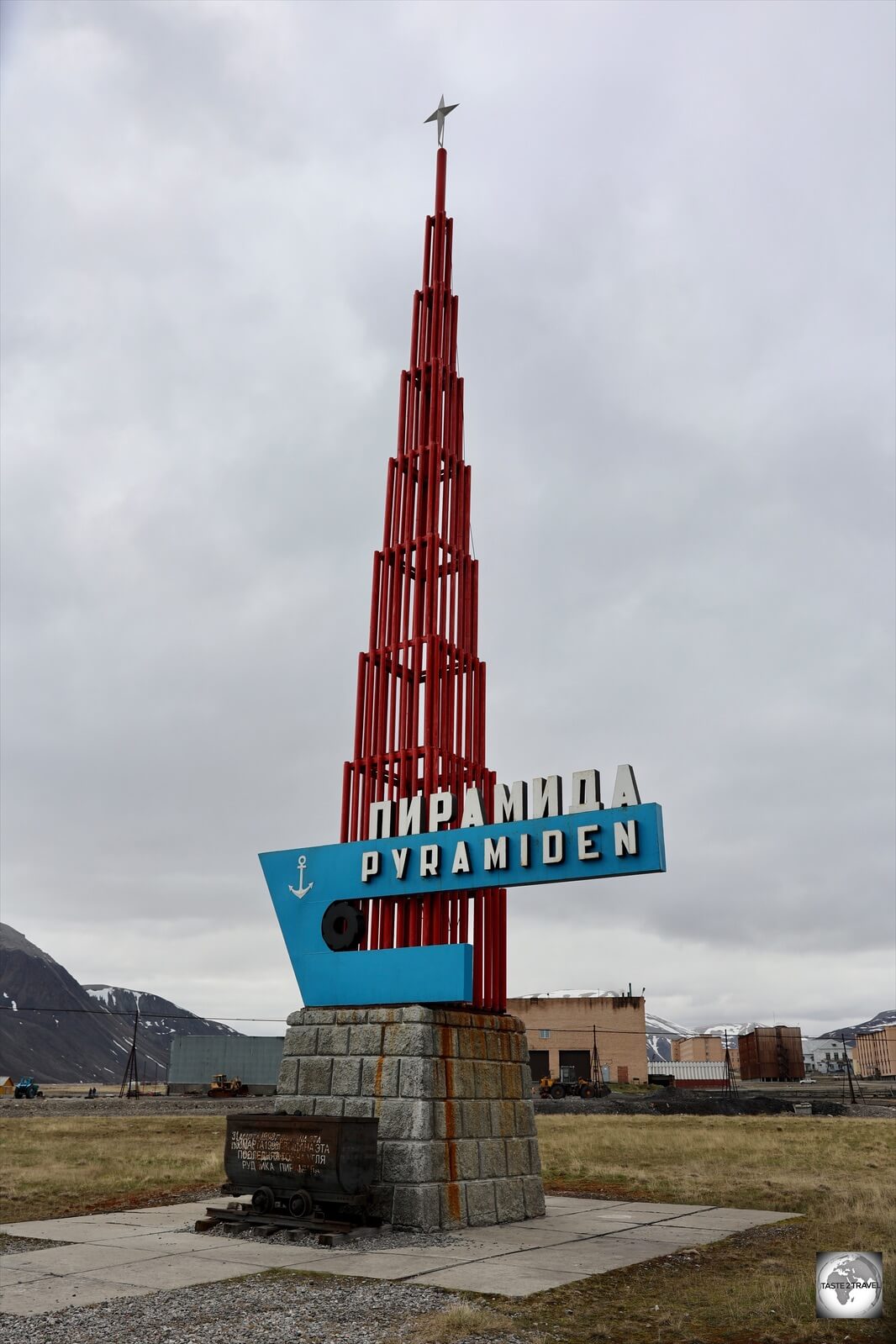
The first stop on a walking tour of Pyramiden is the memorial stele near the edge of town.
The last ton of coal was extracted in 1998 and is now displayed in a coal wagon which is at the base of the memorial stele.

Soviet emblems on the wall of the cultural hall.
In 1998, the town was then abandoned – frozen in time in this frozen land!

Notices on the community notice board inside the cultural centre at Pyramiden.
Everything remains in place, including notices on the community notice board, in what has become a time capsule of Soviet Arctic life from last century.

Wedding announcement on the community noticeboard in Pyramiden.
Pyramiden is a fascinating tourist attraction and should not be missed!

Soviet-era apartment buildings in Pyramiden.
Prior to the pandemic, I was fortunate enough to visit the abandoned Soviet city of Pripyat in the Chernobyl exclusion zone.
There are many parallels between Pyramiden and Pripyat, including the fact that they were both built as model Soviet towns and now lie abandoned, frozen in time.

A view of the auditorium, a part of the cultural centre in Pyramiden.
Since 2007, there has been a concerted effort to make Pyramiden a tourist attraction, this included a renovation of the town’s one hotel, Hotel Pyramiden, in 2014.

The last ton of coal extracted at Pyramiden is on display at the town entrance.
During the winter months, when sea ice blocks access to the town, there are a staff of 10 caretakers in town.

The swimming hall at Pyramiden features many beautiful design elements.
During the summer tourist season, there are a team of 20 staff who run the hotel, the one shop, the one cafe/ bar and provide tour guiding services.

Our Russian guide, who was required to carry a loaded rifle as protection against polar bears.
Due to the presence of polar bears in the area, guides carry loaded rifles and you must not wander off!
As a model city, Pyramiden was blessed with many facilities which otherwise wouldn’t have existed in a such a remote, tiny town. Everything was built featuring Soviet architecture, which bears witness to a past heyday which has now past.
Pyramiden provides a fascinating window into life in a Soviet-era Arctic town.

The kitchen, at what was once the 24-hour staff cafeteria in Pyramiden.
The main avenue, which is overlooked by a bust of Lenin (of course!), is lined with many impressive buildings, including the staff cafeteria.

The beautiful ‘Polar’ mosaic which is the centrepiece of the staff cafeteria at Pyramiden.
The cafeteria is accessed via a twin staircase, above which is a large, and once beautiful, mosaic of an arctic landscape.

The abandoned staff cafeteria at Pyramiden.
In Pyramiden’s heyday, up to 1000 people used to eat in the cafeteria, which was open 24 hours per day! Today it’s large, empty and silent!

The world’s northernmost swimming pool – the swimming hall in Pyramiden.
Also on the avenue is a swimming hall, featuring lots of fancy wooden panels and an ornate wooden ceiling. All wood on treeless Svalbard has to be imported!

Entrance to the swimming hall in Pyramiden.
The crowning glory of the town was the sports and cultural centre which is located at the top of the avenue.

The entrance to the cultural centre in Pyramiden.
This large building featured an auditorium with rows of comfortable red seats, sports hall, library, music rooms and even a ballet studio. Not bad for a remote Arctic town.

The auditorium in the cultural centre in Pyramiden.

The sport hall inside the cultural centre at Pyramiden.

Music room in the cultural centre at Pyramiden.

A sound-proof music studio in the cultural centre at Pyramiden.

Ballet studio in the cultural centre at Pyramiden.
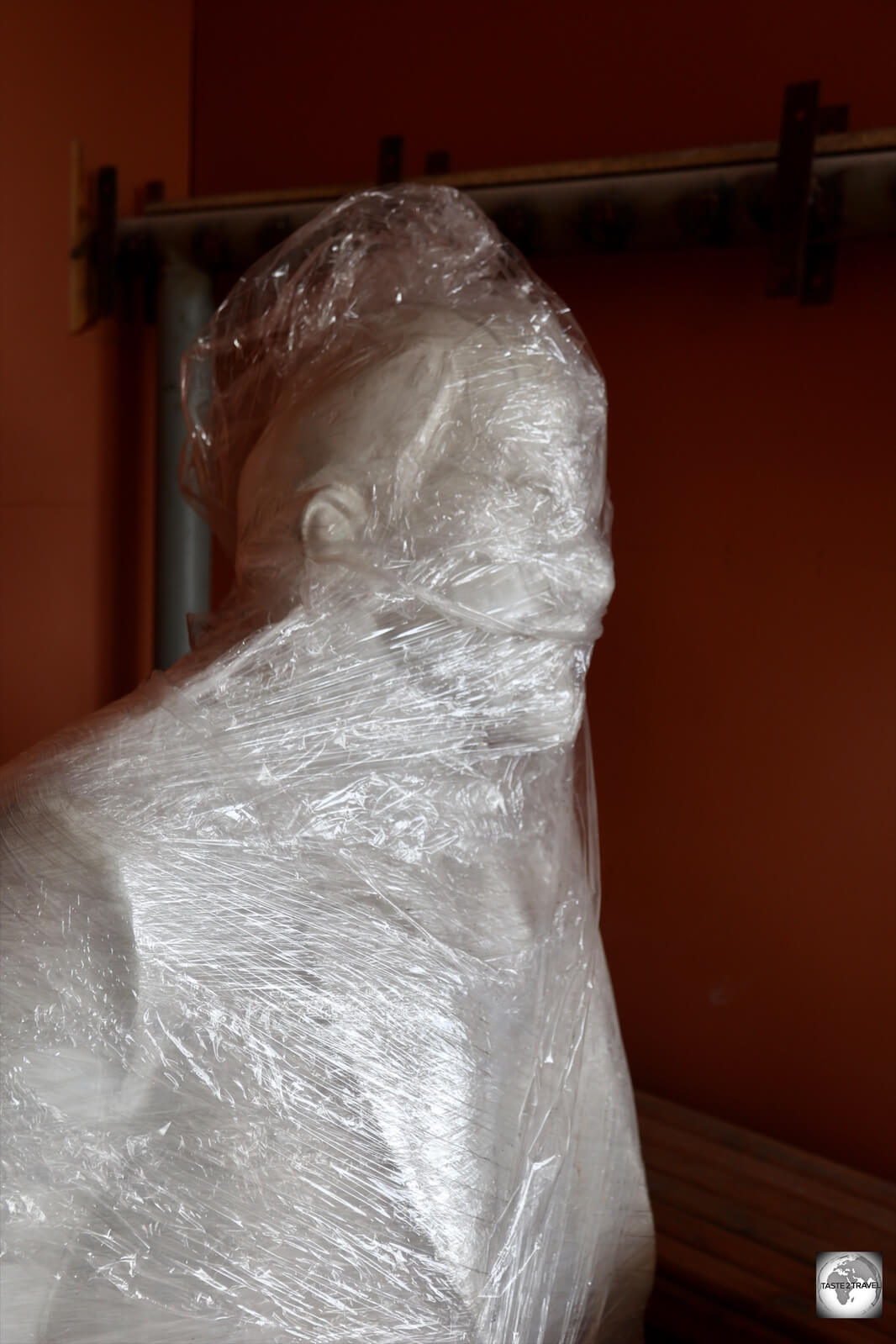
A bust of Lenin in storage at the cultural centre in Pyramiden.
While the human residents have left, thousands of new residences have moved in!

Seagulls nesting on the window ledges of an abandoned apartment block in the former Russian mining town of Pyramiden.
As is the want of mother nature, Seagulls have established nests on the window ledges of the abandoned apartment buildings.

Seagulls nesting on the window ledges of an abandoned apartment block in the former Russian mining town of Pyramiden.
For the seagulls, these buildings are just another sea cliff with lots of convenient nooks for nests.
Accommodation

One of my rooms at the Radisson Blu hotel, the best accommodation option in Svalbard.
Tip: For a complete listing of all accommodation options on Svalbard, please refer to the “Where To Stay” page on the Visit Svalbard website.
There are currently a total of 6 hotels, 1 apartment complex, 4 guest houses and 1 camping ground available in Longyearbyen. I’ve included details for the main properties below with current (Summer 2022) room rates.
Capacity Constraints
Booking accommodation in Longyearbyen can be tricky, especially during the busy summer cruise ship season.
Hotel beds are limited and, during my stay, the town was completely booked out on more than one occasion, due to an influx of cruise ship passengers.
While many passengers arrive and depart on special charter flights, some choose to extend their stay in the Arctic by checking into hotels in Longyearbyen.
While staying at the 128-room Radisson BLU Polar hotel – the largest hotel in town – a group of 100 cruise ship passengers checked in, waiting to join their ship the following day. This one group filled most of the hotel!
While there are capacity issues, I was told by local tourism operators that there are no plans to add additional rooms by building more hotels and that there is no desire from local authorities to encourage mass tourism to what is a special, and fragile, part of the planet.
The best option is to first check hotel availability prior to booking flights, lest you end up sleeping outside with the polar bears!
Accommodation Costs
As with all other travel costs on the archipelago, accommodation costs on Svalbard are high!
The high costs are completely understandable when you consider market conditions – a remote town, removed from the rest of the world, with limited room capacity and huge (summer time) demand.

Housing in Longyearbyen is limited with most properties owned by companies who use them to house their workers.
Normally, in such a tight market, you could look at alternative accommodation options such as Airbnb. However, you will find nothing listed on that website, due to the fact that there is an apartment shortage in Longyearbyen. Most properties are privately owned by companies who use them to house their staff.
As an example of hotel costs, a ‘standard twin’ room at the Coal Miners’ Cabins, one of the few budget options in Longyearbyen, currently costs NOK1,445 (€138) per night, while an ‘economy twin’ room costs NOK1,245 (€119) per night.
The hotel offers 73, spartanly furnished rooms, with almost all rooms using shared bathrooms / toilets, which are located at the end of the corridor.
It’s hostel facilities at hotel prices!
If you wish to have a private bathroom, you will need to book one of their 3 ‘family’ rooms, which sleeps up to 4 people, and costs NOK4,295 (€413) per night.
Longyearbyen Accommodation
Longyearbyen is the main town on Svalbard, offering the only real selection of services such as shops, accommodation, restaurants, transport etc. All hotels include a buffet breakfast in their rates.
Radisson Blu Polar Hotel Spitsbergen

Another of my rooms at the Radisson BLU hotel, my favourite accommodation in Svalbard.
The flagship property from the omnipresent Hurtigruten group, the cosy Radisson Blu Polar Hotel is the largest, and best, hotel in Longyearbyen.
Offering 128 very comfortable and well-appointed rooms, this is the hotel of choice for cruise ship companies looking to accommodate large groups of passengers. Finding a room can be tricky if there are boats in town!
Apart from their comfortable rooms, the hotel offers a fine dining restaurant and the world’s northernmost pub (refer to the ‘Eating Out‘ section for more details).
Current published room rates are:
- Standard Twin/ Double: NOK2,395 (€230)
- Junior Suite: NOK2,845 (€274)
- Suite: NOK3,595 (€346)
Funken Lodge
Another property by the Hurtigruten group, Funken Lodge offers 88 rooms in what was formerly the accommodation quarters for single employees of the trading company Store Norske.
Current published room rates are:
- Standard Double/ Twin: NOK3,340 (€323)
- Standard Single: NOK3,020 (€292)
Svalbard Hotel | Polfareren
One of three hotels offered by the Svalbard Adventures company, the Svalbard Hotel | Polfareren offers 49 rooms on the main street.
Current published room rates are:
- Superior Room: NOK3,348 (€323)
Svalbard Hotel | The Vault

My ‘Standard Single’ room at The Vault hotel, which cost the princely sum of NOK 2,555 (€246) per night.
Another property by Svalbard Adventures, Svalbard Hotel | The Vault is named after the Global Seed Vault and includes a world map in the lobby, indicating locations from which seed donations have been made to the vault.
The hotel offers 35 rooms in total, with 33 double rooms and 2 single rooms. The cost difference between the two room types is just NOK100 (€10) so, even for a single traveller, it’s worth paying the extra for a larger room with a larger bed.
Unfortunately, I had no choice but to accept a single room as the hotel was fully booked. My room was very pokey, being not much larger than the single bed.
Current published room rates are:
- Single: NOK2,550 (€246)
- Double: NOK2,650 (€256)
Svalbard Hotell | Lodge
Also, by Svalbard Adventures, Svalbard Hotell | Lodge offers 10 apartments in the heart of town, with each apartment accommodating either 4 or 6 guests.
Current published room rates are:
- 4-guest Lodge: NOK3,750 (€362)
- 6-guest Lodge: NOK3,750 (€362)
Mary-Ann’s Polarrigg
A project of love by owner Mary-Ann Dahle, the very eclectic Mary-Ann’s Polarrigg is housed in a former miner’s barracks. This quirky establishment, which has been furnished with relics from former coal mines, includes 17 single, 19 double and four family rooms.
Current published room rates are:
- Single: NOK1,195 (€116)
- Double: NOK2,295 (€223)
- Family Rooms: NOK3,295 (€319)
Basecamp Hotel
If ever you wished to experience the life of a wildlife trapper living in the wilderness, a rustic room at the Basecamp Hotel could be for you.
Modelled on a typical trapper’s hut, complete with modern conveniences and a pub next door, the Basecamp Hotel offers 16 rooms in the heart of Longyearbyen.
Current published room rates are:
- Single: NOK1,390 (€135)
- Twin: NOK2,090 (€203)
- Triple: NOK2,390 (€232)
- Suite: NOK2,990 (€290)
Nybyen Guesthouses
Located 2 km inland from Longyearbyen, at the end of the glacial valley, the small settlement of Nybyen (New Town), was originally established to house the coal miners from mine 2A.
The former accommodation cabins are today home to the two cheapest guest houses in town. Both properties offer basic rooms, with shared bathrooms and toilets at the end of the corridor!
Coal Miners’ Cabins
The budget offering by the Hurtigruten group, Coal Miners’ Cabins charges hotel rates for hostel facilities! This is one of the more affordable options in town, although it’s located 2 km outside of town at the end of the glacial valley.
This guesthouse offers 76 rooms, with almost all rooms using shared bathrooms. The only rooms with private bathrooms are a couple of “Family” rooms.
I spent 4 nights in a spartanly furnished “Economy Twin” room, using a (busy) shared bathroom and toilet at the end of the corridor.
Current published room rates are:
- Economy Twin (2 persons – shared bathroom): NOK1,445 (€140)
- Standard Twin (2 persons – shared bathroom): NOK1,645 (€159)
- Large Twin with sink (2 persons – shared bathroom): NOK1,745 (€169)
- Family Room (4 persons – private bathroom): NOK4,295 (€415)
Gjestehuset 102
Across the road from Coal Miners’ Cabins, this guesthouse was originally built to house miners from coal mine #2A and was formerly known as the “millionaires’ mansion”, being home to the best and most experienced miners.
Gjestehuset 102 has 61 beds (7 singles, 19 doubles and 4 four-person dorms).
Current published room rates are:
- Bed in mixed 4-person dormitory (shared bathroom): NOK500 (€48)
- Standard Double (2 persons – shared bathroom): NOK1,330 (€129)
- Standard Single (1 person – shared bathroom): NOK930 (€90)
Barentsburg Accommodation
Barentsburg Hotel

The Barentsburg Hotel is the one hotel in town. If you do stay overnight, you might be the only guest!
The main game in sleepy Barentsburg, the Barentsburg Hotel offers 46 rooms, including 5 suites and 41 standard twin rooms, with a total of 92 beds.
Current published room rates are:
- Single: NOK1550 (€149)
- Double: NOK1900 (€183)
- Suite: NOK2100 (€202)
Pomor Hostel

The Pomor hostel is the only other accommodation option in Barentsburg.
Located next door to the Barentsburg Hotel, the Pomor Hostel is the cheapest option in town. Offering 30 double and triple rooms (all with shared bathroom), with a total of 72 beds.
Current published room rates are:
- Twin: NOK1,000 (€96)
- Triple: NOK1,200 (€115)
Breakfast costs an additional NOK200 (€19,20)!
Pyramiden Accommodation
Hotel Pyramiden
The only accommodation option in this fascinating former Russian mining town, Hotel Pyramiden offers 43 rooms, including 38 standard rooms and 5 suites.
It’s important to note that there is no WiFi or mobile phone signal anywhere in Pyramiden. If you wish to drop off the grid, this is the place for you! Best to bring a good book!
Current published room rates are:
- Single: NOK2000 (€192)
- Double: NOK2500 (€240)
- Suite: NOK3000 (€288)
Eating Out
For a small, remote settlement at the top of the world, Longyearbyen offers a superb range of dining options, which are on par with anything you’d find on the mainland.
Being a compact town, everything in Longyearbyen is a 5-minute walk, with this town of 2,500 souls boasting 6 restaurants, 2 cafés and 5 bars.
Tip: For a full list of dining options on Svalbard, you should refer to the Food & Drink page on the Visit Svalbard website.
Dining Costs
Most hotels in town include a buffet breakfast in their nightly rate.
For lunch, the place of choice for most locals and tourists is Fruene café, which is one of two cafes in town, and the only cafe serving food. A typical lunch, with a coffee, costs between NOK150 – NOK200 (€14.75 – €20).
For dinner, a main course of either steak, fish or local reindeer will cost around NOK350 (€35), with a glass of local beer costing up to NOK90 (€8.74) for a pint.
Restaurants
Restaurant Nansen
Located inside the Radisson BLU Hotel, Restaurant Nansen is one of several food and beverage options in town from the Hurtigruten group. This is the place to dine if you are curious to try Arctic ingredients combined with Asian flavours.
For those staying at the Radisson BLU, the daily breakfast buffet, the best in town, is served in the restaurant.
Stationen

Restaurant Stationen offers a selection of international and Norwegian cuisine.
Stationen, whose name is inspired from the many whaling stations which once existed on Svalbard, offers a selection of international and Norwegian cuisine which is served in what used to be the former miner’s cafe – cafè Busen.
Another cosy establishment, restaurant Stationen serves generous, flavoursome meals portions, along with Svalbard brewery beers.
Kroa Restaurant
The cosy and inviting Kroa Restaurant, which is operated by Basecamp Spitsbergen, serves delicious sandwiches, soups, pizza, steaks, fish and more in a very warm and friendly, ‘log cabin-esque’ environment. If you are in need of a warm and cosy gastro-pub, Kroa is the place.
Open for lunch and dinner, sandwiches are priced on the menu at around NOK140 (€13.50) while a hamburger will set you back NOK180 (€17.30). At dinner, a steak or fish meal costs around NOK330 (€32).
Svalbar

The popular Svalbar offers very good hamburgers and pizzas which pair well with the local craft beers.
One of two restaurants owned by Svalbard Adventures, the busy and popular Svalbar serves up a menu of hamburgers and pizza – all of which are wonderfully tasty!
I can personally recommend their Blue Cheese burger which is priced at NOK175 (€17). Pizzas, which are cooked in a brick oven, cost on average NOK159 (€15.28).
Beers from the Svalbard brewery cost either NOK69/ €6.78 (.33L) or NOK89/ €8.74 (.5L).
Polfareren Restaurant
The 2nd offering from Svalbard Adventures is the delectable Polfareren Restaurant at the Svalbard Hotell. If you wish to try local Svalbard reindeer, this is the place to do it, with a reindeer main course priced at NOK375 (€37).
Cafés
Café Fruene
Of the two cafes in Longyearbyen, Café Fruene is the main game! Located on the main street, opposite the Coop supermarket, this large, popular cafe, which is the default lunch venue for locals and tourists, is especially busy whenever cruise ships are in town.
The powerhouse of this bustling operation is a team of efficient Filipinos who keep things moving.
Apart from serving delicious homemade soups, sandwiches, cakes, pastries and coffee, the cafe produces their own (very fine) chocolates – which makes them the world’s northernmost chocolaterie.
Café Huskies
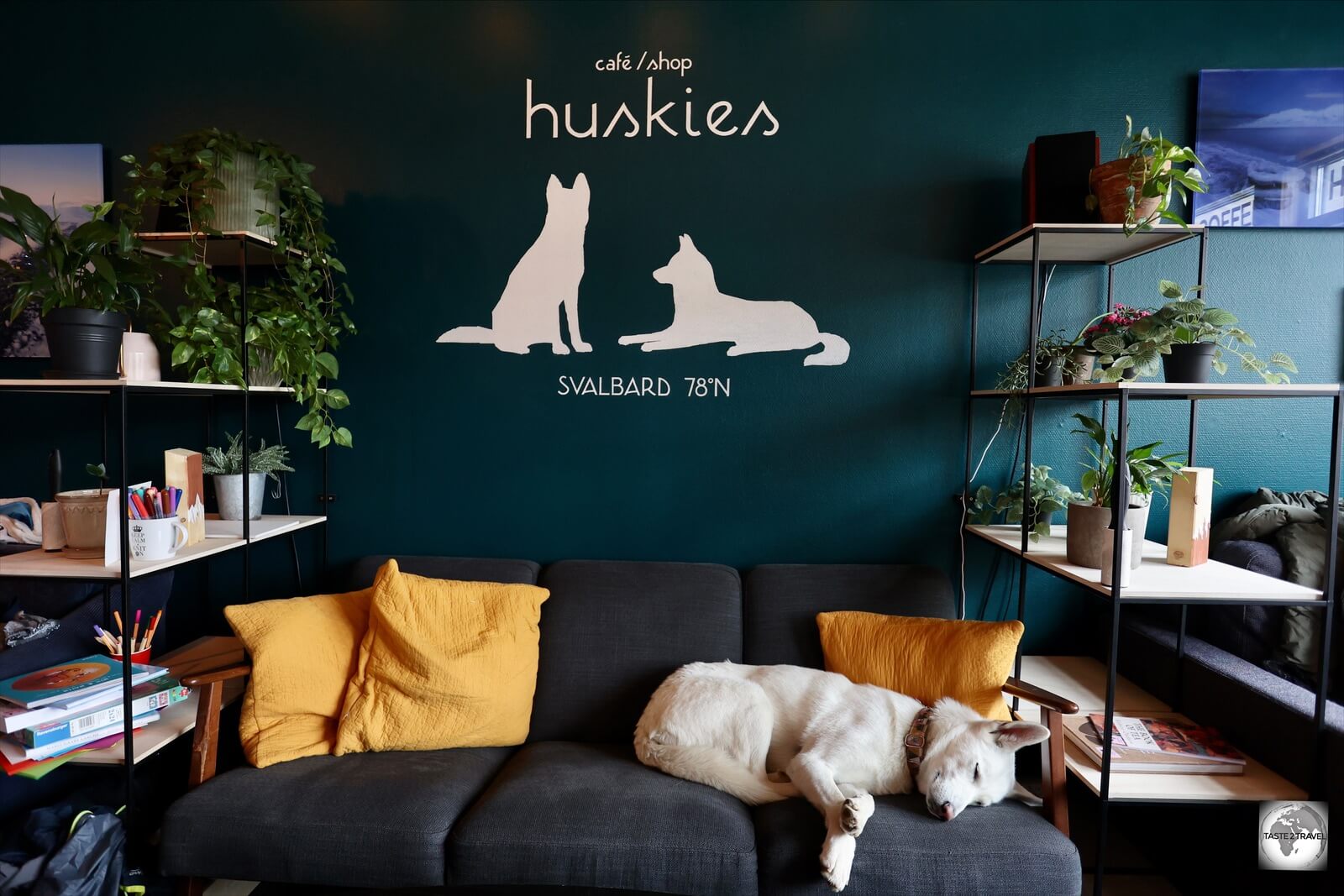
The very inviting Café Huskies features a couple of friendly husky dogs.
Located on the main road, opposite the Radisson BLU hotel, the low-key Café Huskies is a cosy and inviting cafe and gift shop. The stars of the café are two friendly husky dogs who love being petted – when they’re not sleeping on the sofa!
While Café Fruene offers a much larger food selection, Café Huskies offer a few different Poke Bowls, sandwiches, coffee and a few sweet treats, including a delicious rhubarb cheesecake.
Tip: If you enjoy Thai food, the Thai shop, next door to Café Huskies, offers a few Thai takeaway options at lunch!
Bars
Svalbard offers 6 bars in Longyearbyen, 2 in Barentsburg and two breweries – one in Barentsburg and one in Longyearbyen.
Longyearbyen
Bars can be found inside the restaurants listed above – namely, Svalbar, Kroa and Stationen. In addition to those bars, there are the following establishments where you can quench your thirst.
Barentz Gastropub

Barentz Gastropub at the Radisson BLU Polar hotel – the world’s northernmost pub.
Located inside the Radisson BLU hotel, the world’s northernmost pub, Barentz Gastropub, is far from chilly. This warm and inviting space is one of the most popular bars in town, serving tasty food and a good selection of Svalbard Brewery beers.

Reindeer stew with a glass of Svalbard brewery beer at Barentz pub in Longyearbyen.
While the pizzas are very good, I especially recommend the local (Svalbard) reindeer stew which is sprinkled with pomegranate seeds and served with a side of mashed potato. Delicious!
Svalbard Bryggeri (Svalbard Brewery)

Beer taps, featuring the full range of beers, in the tasting room at Svalbard Brewery.
When in Longyearbyen, it’s impossible to miss the local brew, which is served in every bar and restaurant.
Located at the port, the world’s northernmost brewery, Svalbard Bryggeri (Svalbard Brewery), is the creation of a former coal miner, Robert Johansen, who, before he could start brewing, spent 6 years on a legal quest to change a law which had prohibited the production of alcohol on Svalbard since 1928!

The brewing room at the world’s northernmost brewery.
The fact that he succeeded is a testament to his passion for his brewing. This passion is evident in the smooth and distinct flavours of his five different craft beers: an IPA, a stout, a pale ale, a pilsner, and a Weiss-bier.

A glass of Svalbard beer is a great way to relax after a day of exploring.
When you brew beer in the Arctic, you have access to a special ingredient – pure glacier water! Sixteen percent of the water used to brew Svalbard Brewery’s beer comes from the nearby Bogerbreen glacier. It’s an ingredient which makes this beer truly unique!
Today, Svalbard Bryggeri supplies every bar and restaurant in Svalbard, exports to Norway and Europe, and runs Brewery tours for locals and tourists.

A very quaffable Stout beer, with 16% glacier water, from Svalbard brewery.
While in Longyearbyen, I personally sampled all of their beers and couldn’t determine my favourite, so I had to start the process all over again!
Karlsberger Pub
If you enjoy quaffing a fine whisky, the Karlsberger Pub is the place for you. Boasting over a thousand different types of whisky, this is the place to warm your soul on a frigid Arctic evening.
Barentsburg
Red Bear Bar & Brewery

The Red Bear brewery in Barentsburg was the first brewery established on Svalbard.
Up until 2014, a law existed on Svalbard which prohibited the production of any alcohol which was stronger than 2.5 degrees. It was in 2014 that Robert Johansen, of Svalbard Brewery, managed to have the law abolished.
Prior to 2014, the Red Bear Bar & Brewery in Barentsburg, which was opened in 2012 – making it the first of the two breweries on Svalbard – brewed a beer which was slightly less than 2.5 degrees.

The brewery at Red Bear Bar & Brewery in Barentsburg.
Today, thankfully, the brewery produces full strength craft beers, including a Pale Ale, India Pale Ale (IPA), Stout and an Imperial Stout, all of which can be sampled at their restaurant.
The restaurant menu includes main courses of hamburgers, fish and steak at around NOK250 (€25) each.
Icebreaker Bar Krasin

Located inside the Barentsburg hotel, the “Icebreaker Bar Krasin” offers a selection of drinks, including ‘Soviet Arctic cocktails’.
Named after the icebreaker “Krasin”, the Icebreaker Bar Krasin includes an interior design inspired by the saloons of old icebreakers. The specialities here include a range of ‘Soviet Arctic cocktails’ which have their origins in the Russian Arctic region.
Visa Requirements
In terms of immigration – Svalbard is unique – it is a true no-man’s land!
Although Svalbard is part of Norway, the Norwegian Immigration Act does not apply to the archipelago. As such, when you fly to and from mainland Norway, you will be stamped in and out of the Schengen zone. There are no immigration formalities on Svalbard.
Foreigners do not need a visa or work and residence permits from the Norwegian authorities to travel to Svalbard. Due to this, Svalbard is a popular place for workers from Asia, especially Thailand and the Philippines. All that is required to live on Svalbard is a paying job.
However, foreign citizens with a visa requirement for the Schengen Area must have a Schengen visa when travelling to and from Svalbard via mainland Norway. There is no other way to access the archipelago.
For those who require a Schengen visa, it’s important to ensure that you apply for a double-entry Schengen visa so you can return to the Schengen Area (mainland Norway) after your stay in Svalbard.
On my return flight to Oslo airport from Svalbard, most of the returning Filipinos didn’t have Schengen re-entry visas and were detained at immigration where they had to wait for a special transit visa to be issued.
Movement anywhere on Svalbard, including between Longyearbyen (Norwegian) and Barentsburg (Russian) requires no passport since the archipelago is owned by Norway.
If you are considering relocating to Svalbard for work, a useful document, which is produced by the Governor of Svalbard is ‘Information for Foreign Citizens in Longyearbyen“.
Getting There

Flights to Svalbard Airport are operated from Norway by Scandinavian Airlines and Norwegian Air Shuttle.
Air
The only airport on the archipelago, Svalbard Airport (IATA: LYR) has the distinction of being the northernmost airport in the world with scheduled public flights.

The terminal at Svalbard airport – the northernmost airport in the world with scheduled public flights.
The airport is located 5 km (3.1 mi) northwest of Longyearbyen on the west coast.
Scheduled Flights
The following airlines offer scheduled flights between Svalbard and Norway:
- Norwegian Air Shuttle – Flies to/ from Oslo and Tromsø
- Scandinavian Airlines – Flies to/ from Oslo and Tromsø
Roundtrip airfares from Oslo to Svalbard during the summer season typically cost around NOK7,000 (€678).
Charter Flights
During the summer cruise ship season, many of the cruise ship companies operate private charter flights to Svalbard, which avoids overwhelming the regularly scheduled flights, with hundreds of cruise ship passengers.
Airport Transport

The Longyearbyen airport shuttle bus operates between all hotels and the airport according to the flight schedule.
Taxis and buses meet each flight with a one-way bus ticket costing NOK 75 (€7.21) or a return ticket costing NOK 120 (€11.54). The bus, whose schedule corresponds to the flight schedule, connects all hotels in Longyearbyen with the airport.
A typical taxi fare is around NOK 180 (€17.30).
Although the airport is just 5 km west of town, walking between town and the airport isn’t allowed, unless you are equipped with polar bear protection – i.e. a rifle!
Getting Around

Road to nowhere! There are just 40 km of roads on Svalbard which are within the town limits of Longyearbyen and Barentsburg.
Road Network

The most popular vehicle on Svalbard is the snow mobile.
There are just 40 km of roads on Svalbard, most of which is in and around Longyearbyen. The only way to travel between Longyearbyen and Barentsburg is by boat. Snow mobiles are the most popular vehicle on Svalbard but are of no use in the drier summer season.
Polar Bear warning signs mark the town limit and should not be passed by anyone on foot unless they are carrying polar bear protection (i.e. a loaded rifle!)

Soviet-era motorbike in Pyramiden.
Public Transport

“Welcome” to Longyearbyen.
Longyearbyen

A daily tour of Longyearbyen is offered by the Svalbard bus company.
There is a modern bus fleet in Longyearbyen, which is operated by Svalbard Bus and Taxi. The buses provide airport shuttle services and transport services for visiting cruise ship passengers.

A view towards Longyearbyen, as seen from the bus tour, from the top of the mountain near coal mine #7.
One of the better value excursions on Svalbard is the daily bus tour (NOK385 / €38) of Longyearbyen which takes you out of town, to the Global Seed Vault and a panoramic viewpoint below the only working coal mine.
Barentsburg

This one antique Russian bus is the sole means of public transport in tiny Barentsburg.
There is one, very cute, antique Russian bus which drives around the two or three streets in downtown Barentsburg.
Taxi
Two taxi companies operate in Longyearbyen – Longyearbyen Taxi and Svalbard Bus and Taxi (Phone: +47 7902 1052).
A typical fare from downtown to the Coal Miners’ Cabins, which are located 2 km out of town, costs NOK 120 (€11.54), while a typical fare to the airport costs NOK 180 (€17.30).
Rental Car

A Svalbard car license plate.
There is one car rental company in Longyearbyen – Arctic Autorent, which can be contacted at:
- Phone: +47 917 02 258
- Email: info@autorent.no
That’s the end of my travel guide for Svalbard.
Safe Travels!
Darren
Further Reading
Other travel reports from the region:
Follow me on Instagram
[Instagram-feed]
[maxbutton id=”1″]
Svalbard Travel Guide Svalbard Travel Guide Svalbard Travel Guide Svalbard Travel Guide Svalbard Travel Guide Svalbard Travel Guide
Svalbard Travel Guide Svalbard Travel Guide Svalbard Travel Guide Svalbard Travel Guide Svalbard Travel Guide Svalbard Travel Guide
Svalbard Travel Guide Svalbard Travel Guide Svalbard Travel Guide Svalbard Travel Guide Svalbard Travel Guide Svalbard Travel Guide
Svalbard Travel Guide Svalbard Travel Guide Svalbard Travel Guide Svalbard Travel Guide Svalbard Travel Guide Svalbard Travel Guide
Svalbard Travel Guide Svalbard Travel Guide Svalbard Travel Guide Svalbard Travel Guide Svalbard Travel Guide Svalbard Travel Guide
Svalbard Travel Guide Svalbard Travel Guide Svalbard Travel Guide Svalbard Travel Guide Svalbard Travel Guide Svalbard Travel Guide
Author: Darren McLean
Darren McLean is an Australian, full-time, digital nomad who has spent 37 years on a slow meander around the globe, visiting all seven continents, 192/ 193 UN countries and 245/ 251 UN+ countries and territories.
He founded taste2travel to pique one’s curiosity and inspire wanderlust.
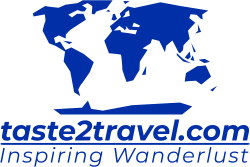




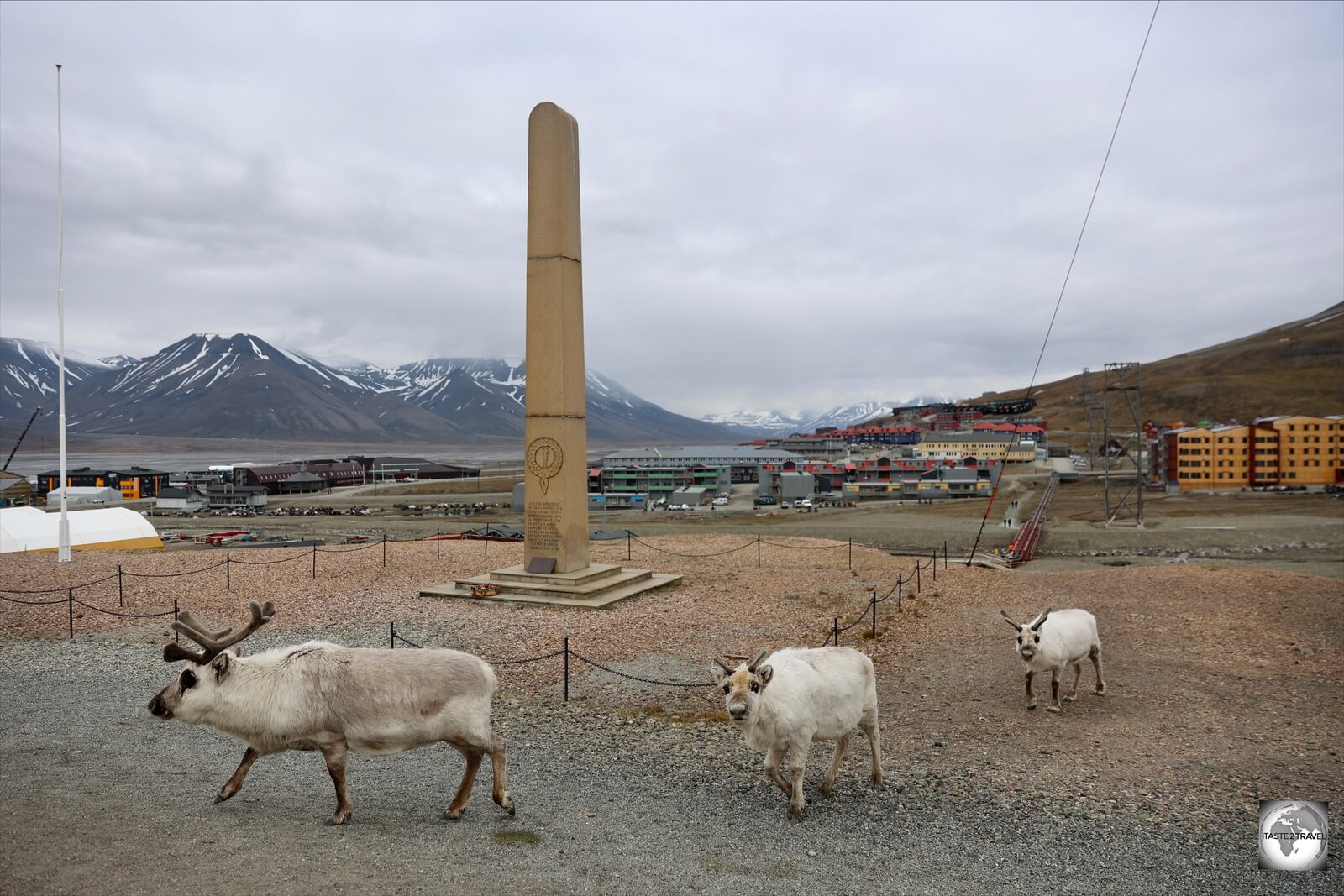
























Another excellent travel guide from Darren! THANK YOU for taking the time to share your experiences and information which are comprehensive and insightful…and of course the pictures, they are beautiful! I look forward to your next travel guide.
Hello Esther,
Many thanks for your positive feedback, I appreciate it very much.
I’m currently working on my Greenland Travel Guide which I hope to publish this week!
Safe travels,
Darren